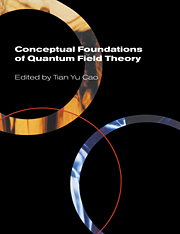Book contents
- Frontmatter
- Contents
- List of contributors
- Preface
- Photographs of the conference
- Introduction: Conceptual issues in quantum field theory
- Part One Philosophers' interest in quantum field theory
- Part Two Three approaches to the foundations of quantum field theory
- Part Three
- Part Four Mathematics, statistics and quantum field theory
- Part Five Quantum field theory and space-time
- Introduction
- 12 Quantum field theory and space-time – formalism and reality
- 13 Quantum field theory of geometry
- 14 ‘Localization’ in quantum field theory: how much of QFT is compatible with what we know about space-time?
- 15 Comments
- Part Six
- Part Seven Renormalization group
- Part Eight Non-Abelian gauge theory
- Part Nine The ontology of particles or fields
- Part Ten
- Name index
- Subject index
Introduction
Published online by Cambridge University Press: 22 September 2009
- Frontmatter
- Contents
- List of contributors
- Preface
- Photographs of the conference
- Introduction: Conceptual issues in quantum field theory
- Part One Philosophers' interest in quantum field theory
- Part Two Three approaches to the foundations of quantum field theory
- Part Three
- Part Four Mathematics, statistics and quantum field theory
- Part Five Quantum field theory and space-time
- Introduction
- 12 Quantum field theory and space-time – formalism and reality
- 13 Quantum field theory of geometry
- 14 ‘Localization’ in quantum field theory: how much of QFT is compatible with what we know about space-time?
- 15 Comments
- Part Six
- Part Seven Renormalization group
- Part Eight Non-Abelian gauge theory
- Part Nine The ontology of particles or fields
- Part Ten
- Name index
- Subject index
Summary
One of the purposes of this conference is consideration of the historical background to the topics under discussion, so I shall open with a historical introduction to ‘quantum gravity’.
Once he completed work on the general theory of relativity at the end of 1915, Einstein began to concern himself with its implications for microphysics. In his first (1916) paper on gravitational radiation, Einstein argued that quantum effects must modify the general theory:
Nevertheless, due to the inneratomic movement of electrons, atoms would have to radiate not only electromagnetic but also gravitational energy, if only in tiny amounts. As this is hardly true in nature, it appears that quantum theory would have to modify not only Maxwellian electrodynamics, but also the new theory of gravitation.
(p. 209)He reiterated this conclusion in his second (1918) paper:
As already emphasized in my previous paper, the final result of this argument, which demands a [gravitational] energy loss by a body due to its thermal agitation, must arouse doubts about the universal validity of the theory. It appears that a fully developed quantum theory must also bring about a modification of the theory of gravitation.
(P. 164)- Type
- Chapter
- Information
- Conceptual Foundations of Quantum Field Theory , pp. 166 - 175Publisher: Cambridge University PressPrint publication year: 1999

